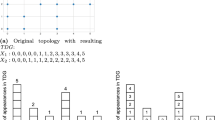Abstract
We present a randomized algorithm for computing the kth smallest distance in a set ofn points in the plane, based on the parametric search technique of Megiddo [Mel]. The expected running time of our algorithm is O(n4/3 log8/3 n). The algorithm can also be made deterministic, using a more complicated technique, with only a slight increase in its running time. A much simpler deterministic version of our procedure runs in time O(n3/2 log5/2 n). All versions improve the previously best-known upper bound ofO(@#@ n9/5 log4/5 n) by Chazelle [Ch]. A simpleO(n logn)-time algorithm for computing an approximation of the median distance is also presented.
Similar content being viewed by others
References
P. K. Agarwal and M. Sharir, Planar geometric location problems, Technical Report 90-58, DIMACS, Rutgers University, New Brunswick, NJ, August 1990. (Also to appear inAlgorithmica).
J. L. Bentley and T. Ottmann, Algorithms for reporting and counting geometric intersections,IEEE Trans. Comput. 28 (1979), 643–647.
M. Blum, R. W. Floyd, V. Pratt, R. L. Rivest, and R. E. Tarjan, Time bounds for selection,J. Comput. System Sci. 7 (1973), 448–461.
B. Chazelle, Some techniques for geometric searching with implicit set representations,Acta Inform.24 (1987), 565–682.
B. Chazelle and D. T. Lee, On a circle placement problem,Computing 1 (1968), 1–16.
K. Clarkson and P. Shor, Applications of random sampling in computational geometry, II,Discrete Comput. Geom. 4 (1989), 387–421.
R. Cole. Slowing down sorting networks to obtain faster sorting algorithms,J. Assoc. Comput. Mach. 34 (1987), 200–208.
R. Cole and U. Vishkin, Deterministic coin tossing with applications to optimal parallel list ranking,Inform. and Control 70 (1986), 32–53.
H. Edelsbrunner,A lgorithms in Combinatorial Geometry, Springer-Verlag, Heidelberg, 1987.
H. Edelsbrunner, L. Guibas, J. Pach, R. Pollack, R. Seidel, and M. Sharir, Arrangements of curves in the plane: Combinatorics, topology and algorithms,Theoret. Comput. Sci. 92 (1992), 319–336.
H. Edelsbrunner, L. J. Guibas, and J. Stolfi, Optimal point location in a monotone subdivision,SIAM J. Comput. 15 (1986), 317–340.
M. Fischer and L. Ladner, Parallel prefix computation,J. Assoc. Comput. Mach. 27 (1980), 831–838.
S. Hart and M. Sharir, Nonlinearity of Davenport-Schinzel sequences and of generalized path-compression schemes,Combinatorica 6 (1986), 151–177.
J. Matoušek, Approximations and optimal geometric divide-and-conquer,Proc. 23rd Annual ACM Symposium on Theory of Computing, 1991, pp. 506–511.
N. Megiddo, Applying parallel computation algorithms in the design of serial algorithms,J. Assoc. Comput. Mach. 30 (1983), 852–865.
N. Megiddo, Partition with two lines in the plane,J. Algorithms 6 (1985), 430–433.
F. Preparata and M. Shamos,Computational Geometry: An Introduction, Springer-Verlag, Heidelberg, 1985.
J. Salowe, Selection problems in computational geometry, Ph.D. Thesis, Department of Computer Science, Rutgers University, New Brunswick, NJ, 1987.
A. Schönhage, M. Paterson, and N. Pippenger, Finding the median,J. Comput. Systems Sci. 13(1976), 184–199.
Y. Shiloach and U. Vishkin, Finding the maximum, merging and sorting in a parallel computation model,J. Algorithms 2 (1981), 88–102.
R. Tamassia and J. S. Vitter, Parallel transitive closure and point location in planar structures,SIAM J. Comput. 20 (1991), 708–725.
R. Tarjan and U. Vishkin, An efficient parallel biconnectivity algorithm,SIAM J. Comput. 14 (1985), 862–874.
L. Valiant, Parallelism in comparison problems,SIAM J. Comput. 4 (1975), 348–355.
A. Yao, On constructing minimum spanning tree ink-dimensional space and related problems,SIAM J. Comput. 11 (1982), 721–736.
Author information
Authors and Affiliations
Additional information
Communicated by Bernard Chazelle.
Part of this work was done while the first two authors were visting DIMACS, Rutgers University, New Brunswick, NJ. Work by the first three authors has been partly supported by Office of Naval Research Grant N00014-87-K-0129, by National Science Foundation Grant DCR-83-20085, and by DIMACS (Center for Discrete Mathematics and Theoretical Computer Science), a National Science Foundation Science and Technology Center-NSF-STC88-09648. Work by the second author has also been supported by National Security Agency Grant MDA 904-89-H-2030. Work by the third author has also been supported by National Science Foundation Grant CCR-89-01484, and by grants from the U.S.-Israeli Binational Science Foundation, and the Fund for Basic Research administered by the Israeli Academy of Sciences.
Rights and permissions
About this article
Cite this article
Agarwal, P.K., Aronov, B., Sharir, M. et al. Selecting distances in the plane. Algorithmica 9, 495–514 (1993). https://doi.org/10.1007/BF01187037
Received:
Revised:
Issue Date:
DOI: https://doi.org/10.1007/BF01187037




